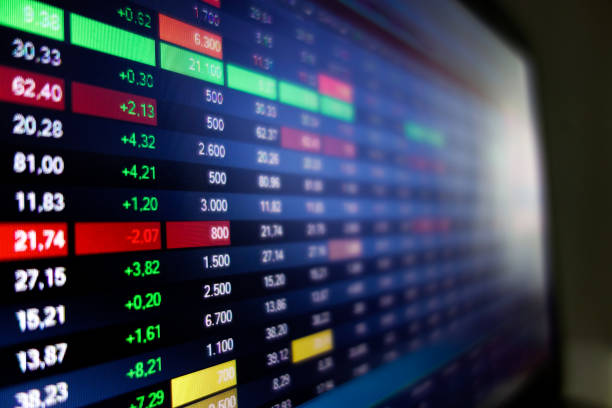
If you are like me and have wondered about this so much, even when you watched movies, where characters were claimed “stock brokers”, it was just something you did not really get. For me, I just had it in mind that the stock market, just had to do with the financial sector and like every market, they had a lot of buying and selling. What they were buying and selling? yea, I had no idea. Where this market was? Also, no clue. If this is you, I promise you to have nothing to be ashamed of. Today, this article will explain to you, what the stock market is about. No stress.
What Is The Sock Market?
First, in simple terms. The stock market is where investors buy and sell shares of a company. It is a set of exchanges where shares of publicly held companies are shared and sold. These financial activities occur through formal exchanges and via over-the-counter (OTC) that operates under strict regulations.
In practice, the term “stock market” often refers to one of the major stock market indices such as the Dow Jones Industrial Average or the Standard & Poor’s 500. These represent a large part of the stock market. Index performance is considered representative of the market as a whole, as it is difficult to track individual companies.
You may see headlines that the stock market is falling or that the stock market is closing or down for the day. In most cases, this means that the stock index has gone up or down, meaning that the overall stock price within the index has gone up or down. Investors who buy and sell stocks want to profit from this stock price movement.
You can hitch back a little, to understand what stocks are.
Understand the inception of the market.
The stock market allows buyers and sellers of securities to meet, interact, and trade. Markets allow companies to set prices for their stocks and act as barometers for the economy as a whole. In a free market, buyers and sellers can rely on fair prices, a high degree of liquidity, and transparency in competing among market participants.
The first stock exchange was the London Stock Exchange, which began in 1773 in a coffee shop where traders gathered to exchange stocks. The first stock exchange in the United States was established in Philadelphia in 1790. The Buttonwood Agreement, so named because it was signed under a buttonwood tree, marked the beginning of New York’s Wall Street in 1792. The contract was signed by 24 traders and was the first American organization of its kind to deal in securities.
A trader changed the company’s name to the New York Stock Exchange in 1817. The stock market is a regulated and controlled environment. Major US regulators include the Securities and Exchange Commission (SEC) and the Financial Industry Regulatory Authority (FINRA). The earliest stock market to issue and trade paper-based physical stock certificates The stock market today works electronically.
How does the market work?
When you buy stock in a public company, you are buying a small amount of stock in that company. Stock markets operate through a network of exchanges. You may have heard of the New York Stock Exchange or the Nasdaq. A company lists its shares on an exchange through a process called an initial public offering (IPO). Investors purchase these shares to raise funds for the company to grow its business. Investors can buy and sell these shares among themselves. Buyers “bid” or offer the highest amount they are willing to pay. This is usually less than what the seller “demands” in return. This difference is called the “bid-ask spread.” The buyer must raise the price or the seller must lower the price for the deal to go through.
This may sound complicated, but computer algorithms typically do most of the price calculations. When buying stocks, you can see the bid, ask, and bid-ask spreads on the website of the broker, but often the difference is only a few cents, which doesn’t matter much for beginners and long-term investors.
The stock market is controlled by the United States Securities and Exchange Commission (SEC). The SEC’s mission is to “protect investors, maintain fair, orderly, and efficient markets, and promote capital formation.” In the past, stock trading probably took place in the physical market. Today, the stock market operates electronically through the internet and online stockbrokers. Although each trade occurs independently, the overall stock price often fluctuates in tandem based on news, political events, economic reports, and other factors.
Functions of the market
The exchange ensures price transparency, liquidity, pricing, and fairness in trading operations. Exchanges ensure that all interested market participants have access to data on all buy and sell orders, contributing to fair and transparent pricing of securities.
The market also ensures the efficient matching of appropriate buy and sell orders. If the price of a stock is determined collectively by all buyers and sellers, the stock market must support price discovery. Those who are eligible and want to trade should be able to place orders quickly, and the market should ensure that orders are filled at a fair price.
Stock exchange traders include market makers, investors, traders, speculators, and hedgers. Investors can buy stocks and hold them for the long term, and traders can enter and exit positions in seconds. Market makers provide the necessary liquidity in the market, and hedge funds can trade derivatives.
The Role of Stock Exchanges: Facilitating Ownership, Price Discovery, and Market Dynamics
The purpose of the stock exchange is to provide a place where anyone can buy and sell fractional ownership of publicly traded companies. It extends control of some of the world’s largest companies to hundreds of millions of private investors. And the buying and selling decisions of those investors determine the value of those companies.
The market allows buyers and sellers to negotiate prices. This negotiation process maximizes fairness for both parties by offering both the highest possible selling price and the lowest possible buying price at any given time. Each stock exchange tracks supply and demand for the stocks listed on it.
Supply and demand determine the price of each security, or the level at which exchange participants (investors and traders) are willing to buy or sell. This process is called price discovery and is fundamental to how markets work. Pricing plays a key role in determining the impact of new information on a company’s value. For example, consider a publicly traded company with a market capitalization (market value) of $1 billion and a share price trading at $20.
How do you invest in the stock market?
Usually, you can start buying stocks online at around 9 o’clock. Anyone with a brokerage account, robo-advisor, or employee retirement plan will be able to access it via the exchange between 2:30 p.m. and 4:00 p.m. ET. You don’t have to be an official “investor” to invest in the stock market. In most cases, anyone can participate. If he gets a 401(k) through his job, chances are he’s already invested in the stock market. Mutual funds, often composed of stocks from many different companies, are common in 401(k)s.
You can purchase individual stocks through a brokerage account or a personal retirement account such as an IRA. Both accounts can be opened with online brokers that allow you to buy and sell investments. A broker acts as an intermediary between you and the exchange. The online broker has made the signup process easy.
Diversifying Your Investments: Stocks, Index Funds, and ETFs for Long-Term Growth
Once you have funded your account, you can take your time and choose the right investment. All investments have risks. But stocks are more risky than other securities and have a higher potential return. A market rally suggests that the value of a diversified stock portfolio will rise over time, but stocks can also fall suddenly. To build a diversified portfolio without buying many individual stocks, you can invest in index funds or a type of mutual fund known as an exchange-traded fund. These funds aim to passively track the performance of the index by holding all the stocks or investments in the index. For example, you can invest in both the DJIA and S&P 500 as well as other market indices through index funds and ETFs.
Stocks and mutual funds are ideal for long-term investments, such as retirement, but not for short-term investments (generally defined as money that needs to be spent within 5 years). If your investment is short-term and has a time limit, there’s a good chance you’ll have to get your money back before the market recovers your losses.
Before You Go…
Hey, thank you for reading this blog to the end. I hope it was helpful. Let me tell you a little bit about Nicholas Idoko Technologies. We help businesses and companies build an online presence by developing web, mobile, desktop, and blockchain applications.
We also help aspiring software developers and programmers learn the skills they need to have a successful career. Take your first step to becoming a programming boss by joining our Learn To Code academy today!
Be sure to contact us if you need more information or have any questions! We are readily available.
[E-Books for Sale]
1,500 AI Applications for Next-Level Growth: Unleash the Potential for Wealth and Innovation
$5.38 • 1,500 AI Applications • 228 pages
Are you ready to tap into the power of Artificial Intelligence without the tech jargon and endless guesswork? This definitive e-book unlocks 1,500 real-world AI strategies that can help you.
See All 1,500 AI Applications of this E-Book
750 Lucrative Business Ideas: Your Ultimate Guide to Thriving in the U.S. Market
$49 • 750 Business Ideas • 109 pages
Unlock 750 profitable business ideas to transform your future. Discover the ultimate guide for aspiring entrepreneurs today!
See All 750 Business Ideas of this E-Book
500 Cutting-Edge Tech Startup Ideas for 2024 & 2025: Innovate, Create, Dominate
Put Your Tech Company on the Map!
Get featured on Nicholas Idoko’s Blog for just $50. Showcase your business, boost credibility, and reach a growing audience eager for tech solutions.
Publish Now$19.99 • 500 Tech Startup Ideas • 62 pages
You will get inspired with 500 innovative tech startup ideas for 2024 and 2025, complete with concise descriptions to help you kickstart your entrepreneurial journey in AI, Blockchain, IoT, Fintech, and AR/VR.
We Design & Develop Websites, Android & iOS Apps
Looking to transform your digital presence? We specialize in creating stunning websites and powerful mobile apps for Android and iOS. Let us bring your vision to life with innovative, tailored solutions!
Get Started Today



